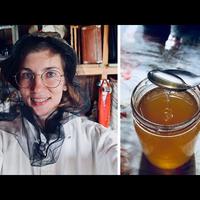BEEKEEPING IN RUSSIA: everything about bees and beehives, how honey is made, work in an apiary. B2C1
Привет, друзья!
Добро пожаловать обратно на канал Russian with Dasha.
Сегодня я расскажу вам о пчеловодстве, то есть
о пчёлах.
Если вы смотрели мои предыдущие видео, выпуски о том, как
мы живём на даче, как мы открывали дачный сезон,
то вы знаете, что на нашей даче есть также пасека,
то есть это пчелиные ульи, и эти пчёлы добывают, собирают
мёд.
Мы собрали наш первый мёд в этом году.
В сегодняшнем выпуске вы узнаете о пчеловодстве
в России, о пчеловодстве на нашей даче, и узнаете
немного информации о пчёлах, поверьте мне, пчёлы - это
удивительные существа, удивительные насекомые.
Я была, если честно, поражена, когда узнала о том, как
они живут, как они добывают мёд.
Вот.
Я надеюсь, что вам понравится сегодняшний выпуск.
Информацию для этого видео я нашла в нескольких советских
книгах по пчеловодству.
Игорь Николаевич занимается пчеловодством с 1991 года.
Сегодня он поделится с нами своим опытом.
Почему пчёлы так важны для этого мира?
Опыление растений на 90% выполняется пчёлами.
Ценность их опылительной работы в 20 раз больше, чем
стоимость получаемых от пчёл продуктов: мёда, воска
и т.д.
Пчела - это настоящее чудо природы.
Она и фармацевт, и врач.
Даже первобытный человек применял мёд как пищевой
продукт и лечебное средство.
Пчелиная семья состоит из 20-80 тысяч рабочих пчёл,
одной матки и нескольких сотен трутней.
В этом видео я расскажу о каждом члене семьи пчёл,
какую функцию они несут, что делают каждый день.
Пчелиная семья живёт в гнезде, заполненном сотами,
которые расположены один относительно другого вертикальными
параллельными пластами.
Соты состоят из шестигранных восковых ячеек.
В них пчёлы выводят потомство, складывают и хранят свои
кормовые запасы.
Летом пчёлы размещаются в промежутках между сотами,
а зимой собираются клубом и занимают свободные от
корма ячейки сотов.
Пчёлы поддерживают в улье постоянную температуру.
Чтобы пчёлам было легче строить соты, в рамку прикрепляют
вощину.
Она представляет собой тонкую пластину воска,
на обеих сторонах которой сделаны углубления по форме
и размерам донышек ячеек пчелиных сотов.
Большинство ячеек в сотах составляют пчелиные - их
до 200000 в улье, трутневых бывает до 1000, а маточных
до нескольких десятков.
Первый тип пчёл - это рабочие пчёлы.
Это особи женского пола с недоразвитыми половыми
органами, неспособные к спариванию с трутнями и
выполняющие работы в пчелиной семье.
Они приносят нектар, перерабатывают его в мёд, делают прополис,
кормят личинок, ухаживают за маткой и кормят её.
Они же строят соты, поддерживают чистоту внутри улья, охраняют
гнездо от насекомых и животных, утепляют гнездо и постоянно
приносят воду.
Такая пчела в летний сезон живёт до 40 дней.
Личинке рабочей пчелы нужен 21 день, чтобы вырасти и
выйти из ячейки.
Уже на второй день своей жизни она начинает работать:
чистить и полировать ячейки, на четвёртый день жизни
она начинает кормить личинок молочком, которое выделяет
её организм.
В 11-дневном возрасте пчёлы начинают принимать нектар
и перерабатывают его в мёд, складывают в ячейки
и запечатывают, а также выносят мусор и охраняют
улей.
На пятнадцатый день своей жизни пчёлы начинают вылетать
из улья и до конца своей жизни работают сборщицами
нектара, воды цветочной пыльцы и клея.
Пчёлы вылетают в поле за нектаром на расстояние
до 2 км.
Если улей перенести на дальнее расстояние, пчёлы
могут не найти дорогу домой.
Если начинается дождь и пчёлы по ошибке залетают
в чужой улей, хозяева впускают только тех, кто несёт нектар,
пыльцу или воду.
Пчёл без ноши хозяева стараются убить.
Пчела, прилетевшая с пустыми лапками, может попросить
разрешения войти в чужой улей: она медленно продвигается,
опустив голову, издаёт особый звук.
Пчёлы-хозяева обнюхивают её и только после этого
впускают в свой улей.
Так у пчелы появляется новый дом.
Пчёлы одной семьи узнают друг друга и пчёл другой
семьи по запаху.
В конце лета пчёлы нередко начинают воровать мёд у
других семей, задача пчёл-охранников не допустить этого.
“Ты мой хороший”.
Следующий тип пчёл - это матка.
Она крупнее пчёл-работниц.
Её задачей является воспроизведение потомства.
Из её яиц появляются рабочие пчёлы, трутни и будущие
матки.
Матка откладывает до 2000 яиц в сутки.
Она всегда окружена “свитой” пчёл, ухаживающих за ней.
Пчёлы её и кормят, и чистят.
Из оплодотворённой спермой трутня яиц рождаются рабочие
пчёлы и матки, а из неоплодотворённых - трутни.
Чтобы из личинки выросла матка, а не рабочая пчела,
её усиленно кормят маточным молочком, а также выращивают
в специальной ячейке.
Матка может прожить до шести лет.
И последний тип пчёл - это трутни.
Это особи мужского пола.
Они оплодотворяют матку.
Никакой другой работы они не выполняют и защищать
гнездо не могут, так как не имеют жала.
После спаривания с маткой трутень погибает.
Когда заканчивается сезон сбора мёда, пчёлы выгоняют
оставшихся трутней из ульев, и те погибают.
Можно сказать, что в пчелиной семье царит матриархат.
Мужские особи нужны только для продолжения рода, всю
работу выполняют женские особи.
Роение медоносных пчёл - это отделение молодых
семей от родительских.
Рой вылетает обычно ближе к полудню, с ним вылетает
старая матка.
Молодая матка остаётся в улье.
Рой прививается на ветке дерева и становится гроздью
их тысяч пчёл.
Если пчеловод вовремя не соберёт рой, то он улетит
в лес.
В лесу пчёлы заранее подыскивают новый подходящий дом для
себя, поэтому очень важно вовремя собрать рой.
Пчеловод сначала переселяет дом в роевню.
Для этого он разжигает дымарь, берёт черпак и связку
веток или перьев.
Под висячий рой подставляют открытую роевню и резко
стряхивают в неё пчёл, затем пытаются собрать оставшихся
пчёл черпаком.
Очень важно не повредить матку.
Чтобы согнать пчёл с веток, используют дым из дымаря.
Когда пчёлы соберутся в роевню, крышку закрывают
и уносят в тёмное прохладное место, чтобы рой остыл.
Вечером рой переселяют в новый улей.
Он сразу же начинает осваивать новое жилище, и уже на следующий
день пчёлы отправляются собирать нектар.
Как общаться с пчёлами?
Многие люди их очень боятся, но по своей природе пчёлы
очень миролюбивы.
Они наиболее активны в защите гнезда, поэтому
не стоит стоять перед входом в улей.
Если неосторожно придавить хотя бы одну пчелу, десятки
её собратьев незамедлительно набросятся на вас.
Голову и лицо нужно закрывать специальной защитной сеткой,
а одежду желательно надевать светлую.
Ну что, как вам мой прикид?
Пчёл раздражают резкие запахи.
Пчеловод должен быть аккуратным, спокойным, тихим и работать
без суеты.
Чтобы собрать мёд, пчеловод отбирает по одной медовой
рамке, смахивая пчёл и отгоняя их дымом.
Пчеловод никогда не забирает мёд, который является кормовым,
ведь этот мёд принадлежит пчёлам.
Отобранный мёд откачивают на медогонке.
Густой, вязкий мёд, который накручивается на ложку,
является зрелым, и чем он гуще, тем лучше по качеству.
Со временем мёд кристаллизуется и становится более плотным.
Кристаллизация - это естественная консервация мёда.
Мёд лучше всего хранить в деревянной посуде, но
можно и в стеклянной.
Также его необходимо хранить в темноте и прохладе.
Мёд - это продукт переработки пчёлами нектара.
Нектар - это раствор тростникового сахара, его пчёлы собирают
с цветковых растений.
Пчела-сборщица хоботком высасывает нектар из цветков,
наполняет им свой медовой зобик и переносит в улей.
Здесь она передаёт нектар пчёлам-приёмщицам, которые
складывают его в ячейки сотов.
В процессе переработки пчёлами тростниковый сахар
расщепляется на плодовый и виноградный.
Пчёлы несколько раз перекладывают мёд из ячейки в ячейку,
испаряют из него лишнюю воду, постепенно концентрируя,
и запечатывают по мере готовности.
В составе мёда имеются соли соляной, угольной,
фосфорной и других кислот, железо, марганец, кальций,
магний, натрий, кобальт и т.д.
Мёд очень полезен как взрослым, так и детям.Собранную с
цветков растений и перенесённую в улей на ножках пыльцу
пчёлы перерабатывают в пергу.
Она является для пчёл белковым кормом, ею кормят личинок
пчёл.
В организме пчёл образуется воск, он выделяется на поверхности
их тела в виде тонких белых пластиночек.
Им пчёлы строят соты и запечатывают ячейки с мёдом.
С почек деревьев пчёлы собирают и перерабатывают
прополис.
Он обладает бактерицидными свойствами и используется
для обмазывания внутренних стенок и заклеивания щелей.
В его состав входят смесь смол и бальзамов, воск,
эфирное масло, витамины и микроэлементы.
Прополис используется человеком в медицине.
Также пчёлы выделяют пчелиный яд, которым парализуют
своих врагов.
Некоторые люди плохо или совсем не переносят укус
пчёл.
Также своими глотательными железами пчёлы выделяют
маточное молочко - это высокопитательный корм для пчелиных маток
и личинок.
На зиму ульи с пчёлами утепляют и помещают в специальный
зимовник, где нет сырости и грызунов.
У пчёл должно быть достаточно мёда, чтобы пережить зиму.
Пчеловод должен также следить за здоровьем пчёл и лечить
их от кишечных заболеваний и клещей.
Ну что?
Нам есть чему поучиться у пчёл.
Не зря в русском языке есть поговорка: “работать как
пчёлка”, то есть быть очень трудолюбивым и постоянно-постоянно
работать.
Друзья, я надеюсь, что вам понравилось это видео и
что вы будете с большей любовью и большим уважением
теперь относиться к пчёлам.
Я буду очень рада вашим комментариям.
А мы пойдём пить чай с мёдом.
Старейший пасечник всея России - Симонов Игорь Николаевич.
На эту идею меня подтолкнула моя беспутёвая жизнь (шутка).
Требовались деньги, поэтому я решил купить улей.
Улей первй я приобрёл в деревне Кубаницы у Веры
Фёдоровны.
Первый раз очень сильно обрадовался, когда в середине
августа этот улей принёс мне целое ведро мёда.
Ну, а с той поры, как говорится, пчёлы роились, пасека увеличивалась.
Пчелиная семья - это своеобразный мир.
Чем меньше вмешиваешься в жизнь пчёл, тем лучше
и для них, и для пасечника.
Поэтому основные мероприятия: весной - это чистка гнезда,
постановка новой свежей вощины, летом - это тоже
постановка вощины, вовремя поставить магазины, ну,
и посмотреть - если заполнены магазины - вовремя откачать
мёд, всё.
Ну, а в зиму надо утеплять конечно: конец августа-начало
сентября, когда ночи холодные, сверху кладёшь моховые
подушки, сокращаешь ледки, всё.
Пчёлы, во-первых, служат не для того, чтобы кормить
человека мёдом, а для того, чтобы опылять растения,
которые дают плоды и так далее, и тому подобное.
Для развития всей флоры требуются пчёлы.
Спасибо за внимание!
Спасибо вам.

